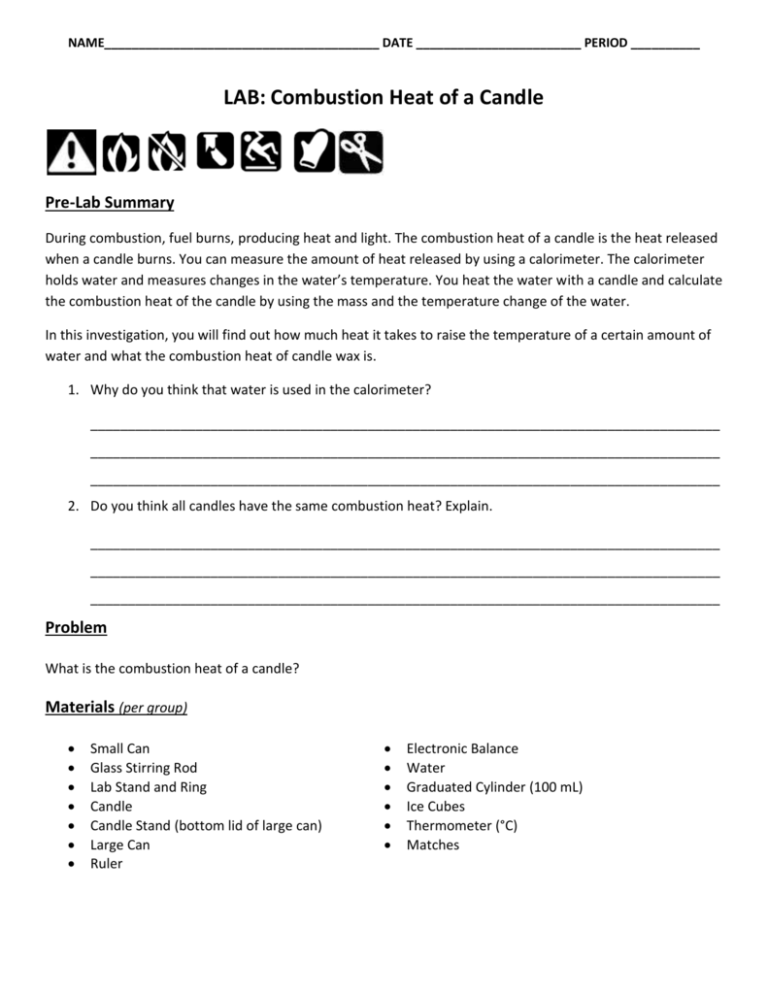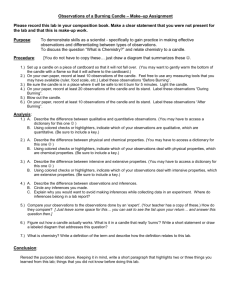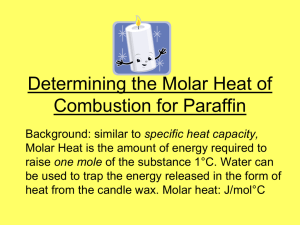Combustion Heat of a Candle Pre
advertisement

NAME________________________________________ DATE ________________________ PERIOD __________ LAB: Combustion Heat of a Candle Pre-Lab Summary During combustion, fuel burns, producing heat and light. The combustion heat of a candle is the heat released when a candle burns. You can measure the amount of heat released by using a calorimeter. The calorimeter holds water and measures changes in the water’s temperature. You heat the water with a candle and calculate the combustion heat of the candle by using the mass and the temperature change of the water. In this investigation, you will find out how much heat it takes to raise the temperature of a certain amount of water and what the combustion heat of candle wax is. 1. Why do you think that water is used in the calorimeter? ____________________________________________________________________________________ ____________________________________________________________________________________ ____________________________________________________________________________________ 2. Do you think all candles have the same combustion heat? Explain. ____________________________________________________________________________________ ____________________________________________________________________________________ ____________________________________________________________________________________ Problem What is the combustion heat of a candle? Materials (per group) Small Can Glass Stirring Rod Lab Stand and Ring Candle Candle Stand (bottom lid of large can) Large Can Ruler Electronic Balance Water Graduated Cylinder (100 mL) Ice Cubes Thermometer (°C) Matches Procedure 1. Insert the glass stirring rod through the small holes in the small can and hang the can by the stirring rod on the support ring on the ring stand (see figure 1 on the last page). 2. Attach the unlit candle to the lid using a few drops of melted wax from a different candle. 3. Record the combined mass of the candle and stand to the nearest 0.1 g and record this value in the data table. 4. Set the unlit candle under the hanging can and adjust the ring so that the bottom of the can is 5 cm above the top of the candle. 5. Remove the small can from the ring stand and take the stirring rod out. 6. Use the graduated cylinder to fill the small can approximately half full of water. In the data table, record the volume of water you use in the can. 7. DO NOT put the small can back on the ring stand yet! Measure the temperature of the water in the small can and record the temperature in the data table. 8. Cool the water with some ice until the temperature drops 10° - 15°C below the initial temperature. Once this temperature is achieved, remove all unmelted ice. Record the temperature of the water after cooling to the nearest 1°C. 9. Insert the glass stirring rod back into the holes in the small can, light the candle and immediately set the large can around the candle, with the air vents at the bottom and hang the small can of water on the ring (see figure 1 on the last page). 10. Stir the water gently with the thermometer (DO NOT let it sit on the bottom of the can!) and observe the temperature change. 11. When the water temperature is about the same number of degrees above its initial temperature as it was below when the ice was added (10° - 15°C), blow out the candle. 12. Continue observing the water temperature. In the data table, record the highest temperature reached by the water. 13. Calculate the change in water temperature (the difference between the cooled water and heated water). 14. Find the mass of the candle and lid after burning and record it in the data table. 15. Calculate the mass of the candle that burned and record it in the data table. 16. Repeat steps 5 – 15 and compare your two sets of results. NOTE: the mass of the candle and lid BEFORE burning in trial 2 should be the same as the mass of the candle and lid AFTER burning in trial 1. Observations Data Table Trial 1 Trial 2 Mass of the candle and lid before burning Mass of the candle and lid after burning Mass of candle burned Volume of water in can Temperature of water Temperature of water after cooling Temperature of water after heating Change in temperature Analyze & Conclude 1. Use the specific heat of water (4.18 J/g°C ) to calculate the amount of heat absorbed by the can of water. Use the following formula: Heat (in joules) = Volume of water (mL) x Temperature change (°C) x 4.18 J/g°C x 1g/mL water 2. Calculate the combustion heat by dividing the heat that the can of water absorbed by the mass of the candle burned. 3. Do you think the water absorbed all of the heat released by the candle? Explain. ____________________________________________________________________________________ ____________________________________________________________________________________ Critical Thinking 1. A candle has a mass of 30 g. How much heat will be released when the candle burns to 1/3 its original height? Use the combustion heat of wax from question 2 in the Analyze & Conclude section. Show your work! 2. How many joules would it take to heat 1000 mL of water at 25°C to a temperature of 30°C? Show your work! 3. How many grams of candle wax would be needed to heat the water in the previous question? (Hint: Use the combustion heat of wax from question 2 in the Analyze & Conclude section) Show your work! 4. Based upon this investigation, describe how you could determine the energy content of foods. ____________________________________________________________________________________ ____________________________________________________________________________________ Small Can Lab Stand Stirring Rod Ring Lab Stand Large Can Can Lid Going Further New Problem If the small can contained a different liquid, such as juice or soda, would the heat required to raise the temperature be the same? Procedure Develop a procedure to measure the combustion heat of the candle using the new liquid. Write the steps on a separate sheet of paper (don’t forget the materials list). The teacher must approve your procedure before you carry out the investigation. Observations On the separate sheet of paper, make a new data table like the one in the original lab to record your new observations. Analyze and Conclude 1. Compare the heat required to raise the temperature of the new liquid to the heat required to raise the temperature of water. Would you expect the two values to be the same? 2. If the new liquid is not water, would you use the value 4.18J/g°C as the specific heat for your calculations?








